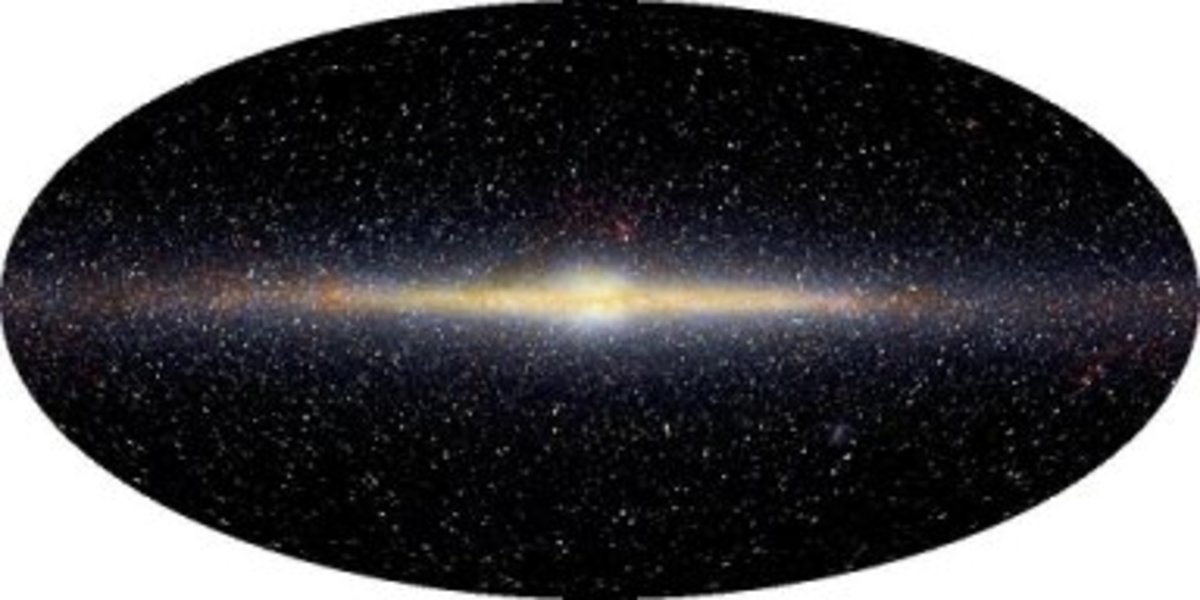Exploding Planet Earth Periodically

Earth's mass extinctions that recurred cyclically generally are presumed initiated or regulated far off, from the periphery of the Solar System or even much, much farther, often by the regular orbits of other celestial things that eventually affect our planet (in "Ateroids and Other Mass Killers", of reference# w2 at the end under 'Web references').
"Periodic Mass Extinction", the hypothesis for a series of such extinctions (in reference #'s wc2 & wc1 at the end), was controversial since a first proposal in 1984. The first hypothesis reported on a periodic cycle of around 26 million years, and was followed by others later with considerably longer cycles.
Much closer mechanisms conceivably may also regulate periodic mass extinctions, possibly with things that accumulate periodically before subsequent explosions that cause disasters.


Within Earth itself, potentially dangerous things could accumulate to destructive limits, and best checked out safely by speculatively "Exploding Planet Earth Periodically" (strange
speculations could lead to more strange things).
Internal heat is generated within planets and released at the outer regions by radiation to space, its flow resisted by the planet's various substances under different conditions.
Internal heat thus can accumulate somewhere in a planet's bowels because of conditions resisting flow, until rising temperatures overcome all resistances and dissipate or relieve the accumulation.
Great enough accumulated heat may be relieved by a single big explosion of the entire planet, or by much smaller ones (periodic or random) that leave the planet intact. Either way might not be nice for the resident species.
Water in its different aspects in a planet may offer considerable resistance to heat flow. It could also be a factor in periodic happenings (water was used in early contraptions called water clocks to mark off time before hardwares like pendulums were invented.
Wet planets like Earth by nature may heat related convulsions, relieved by either periodic or random explosions.
Water's solid and nebulous aspects (ice & steam) were speculated factors in the explosion of an entire ice covered planet between Mars and Jupiter (in "Exploding a Planet", reference # w3).
The possibility of a previous planetary explosion in the said region of space had been an issue with astronomers since the 1800's (in "Exploding Planets", reference # pb3 at end under 'Printed references').
Steam's resistance to conducted heat is one reason why some people can walk on hot coals (in "The Amateur Scientist", reference # pa2). Sweat on the soles gassifies above the coals absorbing some heat and becomes a film of steam underfoot that block heat (coal ash also helps) as the walker trods on without dily-dalying. There are other variations on the principle, like the licking of hot knife with a brave one's tongue.
Considerable seawater may be brought to Earth's hot bowels as oceanic plates ram into and under continental plates (in "Water - 400 Miles Below Earth's Surface", reference # pa3), plunging waterlogged crust deep into the interior.
Bowel heat absorbed by seawater gassifies the later, and may accumulate as steam heat somewhere under Earth's crust.
Other gasses, like air or some gassified substances, may also accumulate under or within the crust through similar or different mechanisms. Rising temperatures possibly may release more gas to accumulate in some available spaces.
Whatever nebulous stuff mixture accumulates under the crust may spread to larger areas, somewhat reducing resistances to horizontal movement on those regions of the crust.
Energy radiated from radioactive materials in the crust (in "The Flow of Heat From the Earth's Interior", reference # pa1), would further raise the temperature of the stuff.
More heat may be directly inputted to the insides of the stuff through radioactive materials that drop from above or were brought in by other means. Radioactive particles may be left suspended that would energize the insides for some time.
Heat inside the nebulous stuff have farther to travel going out the larger the stuff volume and may raise internal temperatures indefinitely accordingly for as long as the right materials come in.
Stuff upper parts may get hot enough to nibble at the crust above and the whole thing or a part may bubble up to higher levels. Laggerd higher stuff bubbles overtaken may be assimilated increasing the rising stuff's bulk and chances of reaching top levels.
Radioactive materials of higher levels are younger and have more heating power the nearer the ground surface (in reference # pa1). A rising stuff bubble may get hotter faster the higher it gets.
(Gas stuff may accumulate enough heat to become plasma stuff if all acquired heat is not outputted. The plasma aspect may be attained by different stuffs or constituents at different temperatures, where relatively very high stuff energies make electrons fly separate from the nucleus of stuff atoms.)
Mass Extinctions Before Man & Apes Parted
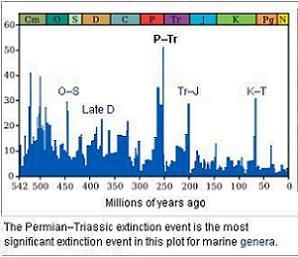
Periodic Mass Extinctions w/ 26 Myr cycles
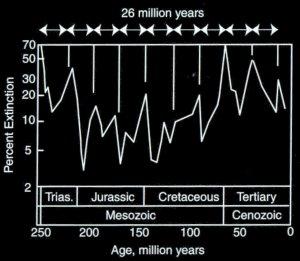
Accumulated heat may be relieved by respectable explosions that eject very hot stuff (likely with lots of crustal crumbs, including other things as conditions permit, like vapor trails similar to the contrails from submarine missiles or else water spouts), to high places, incidentally causing mass extinctions (periodically or randomly as the case may be).
(The tragic consequences of sun blocking stuffs in the atmosphere to Earth and mankind were studied by scientific entities in connection with a possible global disaster called "Nuclear Winter" resulting from a few nuclear explosions in warfare - in "Prophet of the Cold and Dark", reference # pb1).
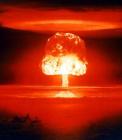
Accumulation and subsequent release of nebulous stuff under or within parts of the crust around the globe may result in in elevating or lowering the topside, possibly powering global oceanic tides that besides powerful crustal explosions may also cause mass extinctions. Conditions in the crust like temperature, buckling or other vertical displacements, etc. may set topside height.
Guatemala sinkhole
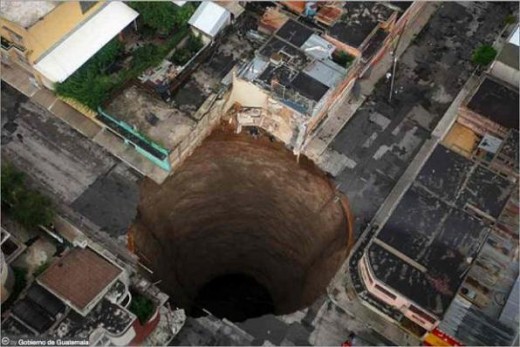
Sinkholes & BHUFO's
Stuff bubbles from Earth's bowels may set enigmatic features on the ground as well as in the air, like sinkholes or UFOs.
Sinkholes, natural pits spacious enough to swallow a building or more, curiously usually have the natural outline of bubbles: a circle.
A stuff bubble rising from below may collapse at the upper levels of the crust, or may escape the surface entirely, depending on bubble energy or on external crustal conditions which in turn may be affected by external factors like the weather. Either way the bubble's last existence on terra firma may be marked by a real estate enigma.
Stuff bubbles that last long out in the open air may include in its constitution some solid or liquid particles that keep heat in a compact volume. Bubble heat and turbulence may keep the particles suspended indefinitely. Some particles may be radioactive and radiate more heat on the bubble's insides.
Spinning may be a tendency of stuff bubbles effected by coriolis force (an imaginary, mathematical & relativistic force referred to Earth's rotation). The bubble thus should somewhat flatten, with the heavier or cooler particles gravitating towards the rim and downwards while the remaining hotter or lighter particles at the center could form a bulging top.
The bubble's form may be temporarily retained & stabilized by the spin, aided by other factors like particles' inertia. Immersion in water or cool environment may give the BHUFO some kind of skin or shell. A columnar cigar form that later topples, set at or above sinkholes may also be another possible shape.
Aerial stuff bubbles of varied bulks could have been mistaken for some UFO's. Environmental conditions as well as bubble internal energy or tendencies may dictate BHUFO external attributes like shape and movement to the likeness of UFOs (BHUFO is acronym for "Bubble Hotstuff Unoccupied Flying Object").
(A detailed analysis on the principles and characteristics of a very common type of BHUFO, the natural flying saucer, is in "Natural Flying Saucer Principles", of reference# w1 at the end.)
A Pre-atomic Age atomic explosion?
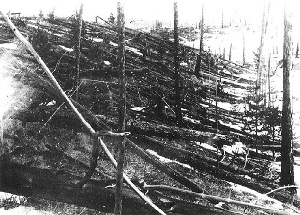
Great Siberian Explosion... (June 30, 1908)
A BHUFO carrying radioactive particles or other explosives may be behind the June 30 1908 Tunguska mystery (in "The Fire Came By", reference # pb2; also in reference # wd2) that remained mysterious for decades.
Gravity and/or movement turns impart acceleration forces that, together with air resistance shape the particles of a moving BHUFO into some compact configuration. The heavier particles of the configuration would move to the leading part, countering air resistance.
The compacting (a good setup for explosives) done as above may be enough to explode some volatile explosives caried (if not all) The higher temperatures at or near the front may also explode some stuff and could force the BHUFO to do an angular tight turn.
For the less volatile explosives that remain, the BHUFO may compact further by losing internal heat that could even cause more violent explosions.
A moving BHUFO, twitched to weird shapes by forces that either cause or resist movement, would lose heat faster than one with unruffled sphere shape.
Plunged into Siberia's very cold environment, a twitching and very hot BHUFO may lose heat rapidly and contract to considerably much smaller volume, compacting the insides some more.
The smaller and tighter the BHUFO gets, the faster its inner regions lose heat (less distance to pass via radiation and conduction). In short period inner particles may compact to very tight configurations through repeated contraction or implosion (on top of the compaction by acceleration forces and air resistances).
Somewhere along the compaction, conditions may have been just right for the type of explosives carried by the tunguska BHUFO.
The bubble did some bomb thing, like atomic fission, fusion, or whatever was feasible with its explosive load. It was only a relatively small natural bomb that cannot precipitate global nuclear winter.
The Tunguska BHUFO may have come in from Earth's upper reaches after a violent exit from Earth's bowels and through some body of water that gave it an impressive contrail, providing some nice atmospheric displays.
More BHUFO's
An alternate source for BHUFO parts may be powdery particles from space that possibly collect at the inner planetary orbits including that of Earth's
Clouds of space powder may accumulate within Earth's influence that may come down as stuff bubbles, periodically or otherwise. The bubble may fly or fizzle, depending on internal heat.
Periodic happenings on Earth may be set by space powder, besides by bowel water or other timing agents.
Reports of UFO manifestations have been observed fluctuating, with prevalence on certain periods (in reference# w1 at the end). Enough of such observations could give indications on wether the actual UFOs, if existing, tend to increase or decrease over time.
Maybe, or maybe not, much bigger BHUFOs are trailing. If observed bubbles were only secondarily generated, then the trailer or trailers may be extraordinarily big.
Humanity's considerable changes underground as well as those in Earth's upper regions may be modern factors to consider for Earth's internal heat movements and processes including the generation of stuff bubbles and BHUFOs.
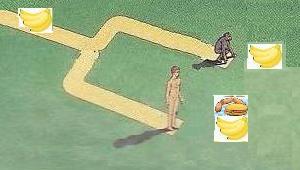
Hopi Indians
The human stock diverged from it's nearest ape relative around 7,000,000_B.C. (in reference # pd1). Periodic mass extinctions as hypothesized occurred before the divergence, with periodic cycles of tens of millions of years and might be expected again in the far future some few million years from now.
Some very recent disasters on the other hand occurred within homo sapiens' late evolution, although maybe mild as compared to events before the human stock appeared (in reference # wa1).
Humans began to have significant impact on the environment around 98,000_B.C. (a tabulation of climate changes since that time with human tool making capabilities are in
reference #'s wa1 & wa2).
The most recent documented disaster occurred around 10,000_B.C. where animal species became extinct. Another event where mammal and plant species disappeared occurred around 48,000_B.C. in reference # wa1).
With such recent occurrences chances are other unknown events close to some other event may have occurred within 98,000_B.C. as well as in the past similar time spans. Mass extinctions, at least the mild ones and their causes may be common.
One or more periodic series of disaster causes with short cycles may be at work at least around current times with the next future events maybe near enough to matter to near generations.
Curiously, periodic worldwide disasters are convictions for some old human groups. Decimations of mankind purportedly occur periodically, destroying some prior flourishing civilization.
The Egyptians in Africa and the Hopi Indians in North America have ancient legends about periodic disasters, including the one about a global flood that is also familiar to current peoples (in reference # pc1).
Earth inundated by a deluge of mountainous waters is a concept common to world cultures, apparently with records extending much farther back than written history. Very ancient methods were used to record the big event, like cave wall paintings as used by some prehistoric cave people worldwide (in reference # pc1).
As recorded, the worldwide disaster was survived by some few people, through different means involving not only various moving crafts like Noah's Ark, but also stationary refuge like underground caverns or mountain tops.
Narratives of the ancients regarding repeated destruction of mankind's civilizations have some notable specifics. Hopis say 3 of mankind's world orders had been destroyed prior to the current setup. Egyptians are less specific about the matter, implying only that many uncounted periodic disasters had occurred (in reference # pc1).
The Hopi legend has a curious detail about an unseen star whose appearance will mark the end of the 4th world order, or of current civilizations to be more specific (a gathering SBUFO might be meant, composed maybe of space powder)
9,000_B.C. is another specific about legendary world disasters. That point in time marks the alleged disappearance of an island continent called Atlantis and the ending of the Atlanteans' worldwide civilization, as told by the ancient Greek philosopher Plato (in reference #'s pc2 & pc1).
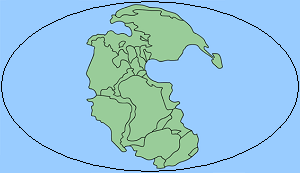
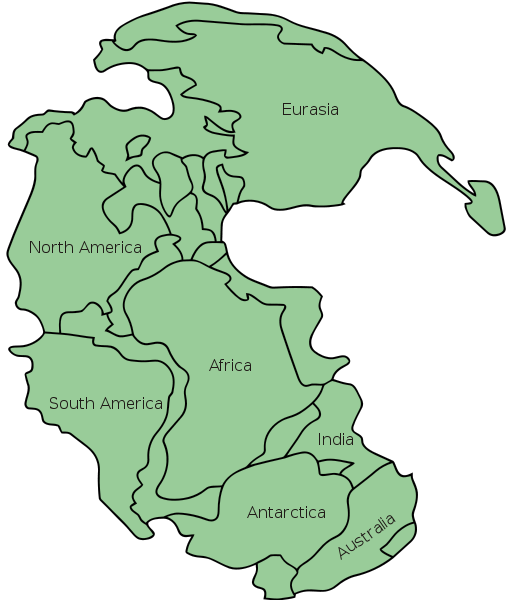
Earth's Interior books
Earth's current lands are pieces from a super continent called Pangaea that broke up starting around 175,000,000_B.C. (in reference #'s wb2, wb3, & wb1; an animation representative of the rifting and separation is at wb2).
Prior to Pangaea many other supercontinents had formed, periodically breaking up and reforming to another supercontinent.
Threats to Earth's residents and civilizations may always be nearby, inside or around Earth, as well as the far off threats that drop by.
Internal heat cause major changes as well as disasters on Earth, to it's surface and the living therein. Around Earth from time to time the speculative nebulous space powder may really gather to drip BHUFO natural atomic bombs.
Threat manifestations may be periodic or random, in the past or thereafter. Calamities disastrous to society and civilization may be expected by humans between now and the far future.
(Periodic global disasters on water bearing worlds could cause the scarcity of highly developed civilizations in the universe and may be a reason why humanity's modern science attempts are fruitless so far in detecting prescence or trace of advanced extraterrestrial civilizations in other stellar areas.)
For disaster recipients it may not matter much if the events are periodic or not, nor if the cause is celestial or terrestrial. But it may matter a lot in terms of readiness that human society straighten it's hangups long before those sad events occur.
Also, Earth's crust progressively thickens. At some point the speculative bowel stuff bubbles may have difficulty exiting and may rather do a faster way, like exploding planet Earth catastrophically more powerfully, as in entirely.
Web references
- w1a.. Natural Flying Saucers at Preexploding Planet Earth
Natural flying saucers considered, are just natural mediums for cooling Earth's interior.

(search key: human activities 100,000 years)
(wa1) search result: "climate Timeline Tool: Climate History Overview"; *****site address= http://www.ncdc.noaa.gov/paleo/ctl/cliihis.html (with tabulation of human tools and environmental changes since around 100,000 years ago)
(wa2) search result: "climate Timeline Tool Overview"; *****site address= http://www.ncdc.noaa.gov/paleo/ctl/overview.html
(wa3) search result: "Homo sapiens sapiens, the true modern human"; *****site address= http://www.ecotao.com/holism/hu_sap.htm (notes: oldest human remains outside Africa 100,000 years ago; **humans flourished at time of neanderthals extinction around 35,000 years ago)
(wa4) search result: "Humans: Origins of Humankind"; *****site address= http://www.pbs.org/wgbh/evolution/humans/humankind/o.html
(search key: Panthalassa)
(wb1) search result: "Panthalassa - Wikipedia the free encyclopedia"; *****site address= http://en.wikipedia.org/wiki/Panthalassa
(wb2) site title: "Pangaea"; *****site address= http://en.wikipedia.org/wiki/Pangaea (through link labelled "Pangaea" at above web reference # www-B1)
(search key: periodic mass extinction, Raup, Sepkoski)
(wc1) Search result: "David M. Raup - Wikipedia - the free encyclopedia"; *****site address: http://www.pnas.org/content/81/3/801.full.pdf (article title: "Periodicity of extinctions in the geologic past"; **note: periodicity cycle of around 26 million years studied with marine fossil data beginning around 248,000,000_B.C.)
(search key: periodic mass extinction)
(wc2) Search result: "What ever happened to the theory of periodic mass extinctions..."; *****site address: http://www.scientificamerican.com/article.cfm?id=what-ever-happened-to-the
(search key: sinkhole explanation)
(wd1) search result: "13 Incredible and Devastating Sinkholes ! Web Ecoist"; *****site address= http://webecoist.com/2008/08/26/incredible-strange-amazing-sinkholes/
(search key: planet explosion hypothesis)
(wd2) search result: "New Hypothesis of the Tunguska Exposion"; *****site address= http://www.spacedaily.com/news/deepimpact-02q.html
Printed references
pa1. "The Flow of Heat From the Earth's Interior" (article in 'Scientific American' magazine for Aug.1977, by David S. Chapman)
pa2. "The Amateur Scientist" (note: (1) about a scientist's walk on hot coals and experiments with water drops on hot surfaces (2) department toic in 'Scientific American' magazine for Aug.1977, by Jearl Walker)
pa3. "Water - 400 Miles Below Earth's Surface" (report in 'Discover' magazine for May 1998, under 'Breakthroughs' of the 'In The News' section)
pb1. "Prophet of the Cold and Dark" (note: (1) consequences on world's atmosphere and environment including "Nuclear Winter" occurrence brought about by nuclear explosions in warfare as studied by scientists and otganizations (2) article in 'Discover' magazine for Jan.1985, by Dennis Overbye)
pb2. "The Fire Came By" (article in 'Reader's Digest for Aug.1978, by John Baxter & Thomas Atkins)
pb3. "Exploding Planets" (article in 'Science Digest' for Apr.1982, by Thomas Van Flandern of the U.S. Naval Observatory)
pc1. "Doomsday 1999 A.D." (book by Charles Berlitz)
pc2. "Solving the Lost Continent Mystery" (notes: (1) summary on the book "The Secret of Atlantis" authored by Otto Heinrich Much (2) article in 'Reader's Digest' for Oct.1978, by Thomas Fleming)
pd1. "Making A Chimp Out Of Man" (article in 'Discover' magazine for Dec.1984, by Jared Diamond)






